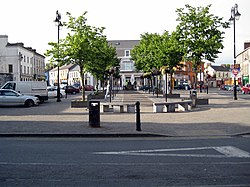Newcastlewest
|
Newcastle West an Caisleán Nua Thiar
|
|
|---|---|
| Town | |

The Square
|
|
| Location in Ireland | |
| Coordinates: 52°27′04″N 9°03′18″W / 52.451°N 9.055°WCoordinates: 52°27′04″N 9°03′18″W / 52.451°N 9.055°W | |
| Country | Ireland |
| Province | Munster |
| County | County Limerick |
| Limerick County Council LEA | Newcastle |
| Dáil Éireann Constituency | Limerick |
| EU Parliament | South |
| Elevation | 55 m (180 ft) |
| Population (2011) | |
| • Town | 6,327 |
| • Urban | 4,880 |
| • Rural | 1,447 |
| Irish Grid Reference | R282336 |
Newcastle West (Irish: an Caisleán Nua Thiar) or simply Newcastle (an Caisleán Nua, formerly anglicized Castlenoe) is a town in west County Limerick, Ireland. It is the largest town in the county, excluding Limerick city, and sits on the River Arra which flows into the River Deel. Newcastle West is in the middle of a great bowl-shaped valley in West Limerick, known one time as the valley of the Wild Boar, apparently due to the abundance of this animal here when the area was thickly wooded. The crest of the town carries the image of a wild boar. Newcastle West is on the N21 road from Limerick to Tralee, between Rathkeale and Abbeyfeale. In 2011, the urban population was 4,880.
Newcastle West grew up around a castle, the ruins of which are located off the town square. The large castle ruins are well maintained.
The castle was built by the FitzGerald family who arrived at some point after 1194, by 1298 the castle had been completed in stone. The town then came to be known as Newcastle, West Limerick, but over time the 'west' became part of Newcastle and the town was known by the current name Newcastle West.
According to Begley, the parish was called Newcastle and Ardagh in 1704. Newcastle was joined with Monagea from 1722 until 1764 when it became a separate parish. Lewis stated that parts of Monagea and Killeedy were in the parish of Newcastle West.
Two notable mentions included in the history of the diocese of Limerick were the first Monsignor in the diocese, Richard Baptist O'Brien in 1881, and Denis Hallinan who was P.P. here and later became Bishop.
Sir William Courtenay, the local landlord, held 10,500 acres (42 km2) of land in Newcastle West in the late 16th century. He was a staunch Catholic, and suffered persecution for his beliefs. His son George may have practiced his faith in secret. Their home was reputed to have had a room in which priests were hidden. William Courtenay was denounced in the House of Commons as a papist recusant in 1624.
...
Wikipedia

